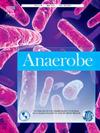脱硫弧菌菌血症与肝脓肿:1例报告及文献复习。
IF 2.6
3区 生物学
Q3 MICROBIOLOGY
引用次数: 0
摘要
我们报告一例罕见的脱硫弧菌菌血症及肝脓肿。一名72岁白人女性,表现为急性发热、僵硬和腹痛。她经验性地使用头孢曲松和甲硝唑,由于败血症引起的低血压需要24小时的肌力支持。腹部计算机断层扫描显示最大直径为6cm的肝脓肿。入院第7天,血液培养提示一种厌氧革兰氏阴性杆菌,随后通过MALDI-TOF质谱鉴定为脱硫弧菌。该菌株对阿莫西林-克拉维酸、厄他培南、莫西沙星、克林霉素和甲硝唑敏感,对哌拉西林-他唑巴坦耐药。尽管入院第2天经皮引流,她的发烧持续了3周。入院第9天将头孢曲松、甲硝唑静脉注射改为阿莫西林-克拉维酸,共给药6周。脱硫弧菌是一种罕见的肝脓肿的病因,在厌氧的情况下,重要的是要考虑螺旋革兰氏阴性杆菌,它可以对包括哌拉西林-他唑巴坦在内的经验抗生素产生耐药性。本文章由计算机程序翻译,如有差异,请以英文原文为准。
Desulfovibrio desulfuricans bacteraemia and associated liver abscess: Case report and literature review
We present a rare case of Desulfovibrio desulfuricans bacteraemia and associated liver abscess. A 72-year-old Caucasian woman presented with an acute history of fevers, rigors and abdominal pain. She was managed empirically with ceftriaxone and metronidazole and required 24 hours of inotropic support due to hypotension from sepsis. A computed tomography scan of her abdomen demonstrated a 6cm liver abscess in maximal diameter. On day seven of her admission, blood cultures flagged an anaerobic gram-negative bacillus, which was later identified by MALDI-TOF MS as Desulfovibrio desulfuricans. The isolate was susceptible to amoxicillin-clavulanic acid, ertapenem, moxifloxacin, clindamycin and metronidazole but resistant to piperacillin-tazobactam. Despite percutaneous drainage on day two of admission, her fevers persisted for three weeks. On day nine of admission, intravenous ceftriaxone and metronidazole were switched to amoxicillin-clavulanic acid, which was administered for a total of six weeks, resulting in clinical resolution. Our case highlights Desulfovibrio desulfuricans as an uncommon cause of liver abscess and one which is important to consider if culturing an anaerobic, spiral gram-negative bacilli. Empirical antibiotics need to be carefully considered as there may be resistance to beta-lactam antibiotics including piperacillin-tazobactam.
求助全文
通过发布文献求助,成功后即可免费获取论文全文。
去求助
来源期刊

Anaerobe
生物-微生物学
CiteScore
5.20
自引率
8.70%
发文量
137
审稿时长
76 days
期刊介绍:
Anaerobe is essential reading for those who wish to remain at the forefront of discoveries relating to life processes of strictly anaerobes. The journal is multi-disciplinary, and provides a unique forum for those investigating anaerobic organisms that cause infections in humans and animals, as well as anaerobes that play roles in microbiomes or environmental processes.
Anaerobe publishes reviews, mini reviews, original research articles, notes and case reports. Relevant topics fall into the broad categories of anaerobes in human and animal diseases, anaerobes in the microbiome, anaerobes in the environment, diagnosis of anaerobes in clinical microbiology laboratories, molecular biology, genetics, pathogenesis, toxins and antibiotic susceptibility of anaerobic bacteria.
 求助内容:
求助内容: 应助结果提醒方式:
应助结果提醒方式:


